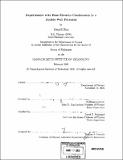| dc.contributor.advisor | Wolfgang Ketterle and David E. Pritchard. | en_US |
| dc.contributor.author | Shin, Yong-Il | en_US |
| dc.contributor.other | Massachusetts Institute of Technology. Dept. of Physics. | en_US |
| dc.date.accessioned | 2008-02-28T16:23:34Z | |
| dc.date.available | 2008-02-28T16:23:34Z | |
| dc.date.copyright | 2006 | en_US |
| dc.date.issued | 2006 | en_US |
| dc.identifier.uri | http://dspace.mit.edu/handle/1721.1/34399 | en_US |
| dc.identifier.uri | http://hdl.handle.net/1721.1/34399 | |
| dc.description | Thesis (Ph. D.)--Massachusetts Institute of Technology, Dept. of Physics, 2006. | en_US |
| dc.description | Includes bibliographical references (p. 153-169). | en_US |
| dc.description.abstract | Trapped atom interferometry was demonstrated with Bose-Einstein condensates in an optical double-well trap. Coherent splitting of trapped condensates was performed by deforming an optical single-well potential into a double-well potential, and the relative phase of the two split condensates was shown to be reproducible. Microfabricated atom chips were developed with prospect for chip-based confined-atom interferometry. The same dynamical splitting scheme was implemented in a purely magnetic double-well potential on an atom chip and interference of two split condensates was observed, but not reproducible phase.Coherent optical coupling between two spatially separated condensates was realized using stimulated light scattering. The relative phase of the two condensates was continuously measured with an optical method, which demonstrated atom interferometry without need for a conventional beam splitter or recombiner. The Josephson-like phase dynamics of the coherent optical coupling was investigated and it was experimentally shown that the induced atomic currents depend on the relative phase of the two condensates and an additional controllable coupling phase. Condensates in an optical dipole trap were distilled into a second empty dipole trap adjacent to the first one. We showed that the distillation was driven by thermal atoms spilling over the potential barrier separating the two wells and then forming a new condensate. This thermodynamic relaxation process serves as a model system for metastability in condensates and provides a test for quantum kinetic theories of condensate formation. | en_US |
| dc.description.abstract | (cont.) Doubly quantized vortices were topologically imprinted in spinor condensates and the stability of the vortex state was investigated. The decay of a doubly-quantized vortex core into two singly-quantized vortex cores was observed using a tomographic imaging technique. The characteristic time scale of the splitting process was found to be longer at higher atom density. | en_US |
| dc.description.statementofresponsibility | by Yong-Il Shin. | en_US |
| dc.format.extent | 169 p. | en_US |
| dc.language.iso | eng | en_US |
| dc.publisher | Massachusetts Institute of Technology | en_US |
| dc.rights | M.I.T. theses are protected by copyright. They may be viewed from this source for any purpose, but reproduction or distribution in any format is prohibited without written permission. See provided URL for inquiries about permission. | en_US |
| dc.rights.uri | http://dspace.mit.edu/handle/1721.1/34399 | en_US |
| dc.rights.uri | http://dspace.mit.edu/handle/1721.1/7582 | |
| dc.subject | Physics. | en_US |
| dc.title | Experiments with Bose-Einstein condensates in a double-well potential | en_US |
| dc.type | Thesis | en_US |
| dc.description.degree | Ph.D. | en_US |
| dc.contributor.department | Massachusetts Institute of Technology. Department of Physics | |
| dc.identifier.oclc | 70215026 | en_US |
